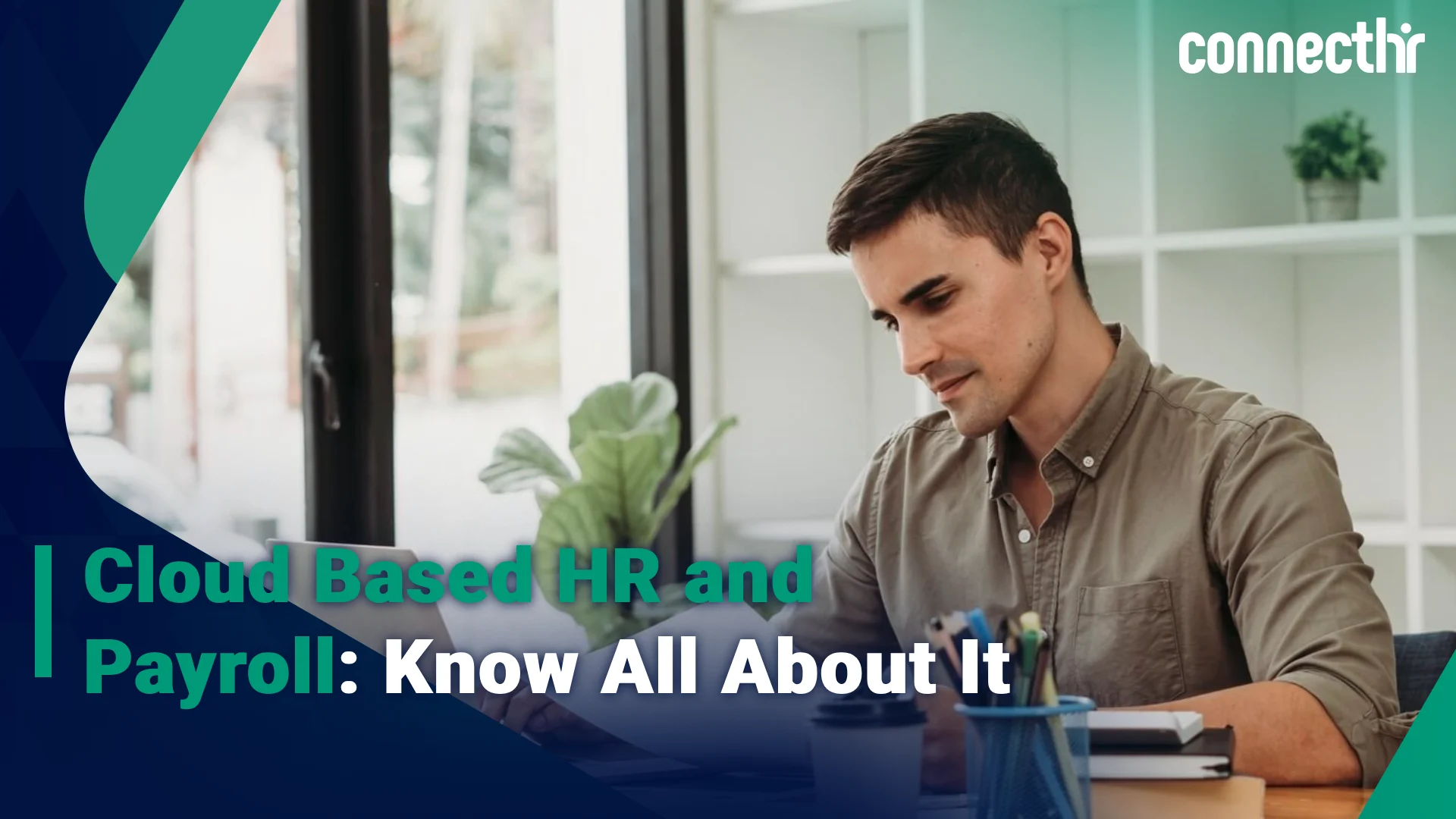Ever wondered about the magic behind streamlined HR and payroll processes? Well, buckle up, because we are about to dive into the world of cloud based HR and payroll. For this reason, it is like having an organizational superhero. To clarify, it is efficient, accessible, and always at your service.
In this article, we will unravel the intricacies of cloud based HR and payroll systems, turning what might seem like a tech maze into a walk in the park. In this regard, at ConnectHR we offer different Payroll Management resources, such as Gratuity Calculation. That said, read on to find out more about this topic!
What is cloud based HR and payroll system?
 In a nutshell, a cloud based HR and payroll system is like having a digital assistant that handles all your HR and payroll tasks, but it is not just any assistant. So, it is a superhero that resides in the cloud.
In a nutshell, a cloud based HR and payroll system is like having a digital assistant that handles all your HR and payroll tasks, but it is not just any assistant. So, it is a superhero that resides in the cloud.
Picture this: instead of relying on physical servers and piles of paperwork, this system harnesses the power of the internet, making HR processes smoother, more efficient, and, dare I say, more enjoyable.
Now, the key ingredient here is the cloud. No, not the fluffy things in the sky, but the virtual space where your HR data is securely stored and managed. Forget about the limitations of traditional on-site servers; with cloud computing, you can access your HR and payroll information from virtually anywhere with an internet connection. That is why at ConnectHR we believe that a good cloud based HR and payroll system can make all the difference!
How does cloud based HR and payroll system work?
We will talk about the functionality. The magic of a cloud-based system lies in its accessibility and real-time capabilities. So, imagine having all your HR and payroll data securely stored in the cloud – employee details, attendance records, payroll information, everything at your fingertips. For this reason, you will need to know more about this system!
Certainly, cloud computing technology ensures that this data is not only stored but also processed and managed in real-time. Now, here is the beauty of it – you can handle HR tasks and execute payroll from anywhere, anytime. The traditional 9-to-5 constraints are a thing of the past. Therefore, cloud-based systems provide the flexibility needed in the modern work landscape, giving you the power to manage your workforce on your terms.
How is cloud computing used in HR?
For this reason, cloud computing has revolutionized HR functions, bringing in a new era of flexibility and efficiency. Here is how it is used:
- Recruitment and Applicant Tracking
- Employee Onboarding
- Performance Management
- Employee Self-Service
- Data Analytics and Reporting
- Recruitment and Applicant Tracking: Cloud-based systems streamline the recruitment process, making it easier to post job openings, track applications, and communicate with candidates.
- Employee Onboarding: Digital onboarding, powered by cloud solutions, ensures a smooth transition for new hires. They can access necessary documents and training materials online.
- Performance Management: Cloud-based tools facilitate continuous performance management, enabling real-time feedback, goal tracking, and development planning.
- Employee Self-Service: Cloud HR systems empower employees to manage their information, access payslips, request leaves, and update personal details, reducing the administrative burden on HR.
- Data Analytics and Reporting: Cloud computing allows HR professionals to gather, analyze, and derive insights from vast amounts of HR data, aiding strategic decision-making.
In other words, cloud-based HR is not just a tool. Moreover, it is a game-changer that enhances the entire employee lifecycle and elevates HR functions to new heights.
What are the benefits of using cloud based HR and payroll system?
Now that we have delved into the workings, we will explore the remarkable benefits that come with adopting a cloud based HR and payroll system.
- Enhanced Accessibility.
- Real-Time Updates.
- Cost Efficiency.
- Data Security.
- Collaboration and Communication.
- Ease of Implementation.
- Automatic Updates.
- Enhanced Accessibility. With everything stored in the cloud, accessibility becomes a breeze. Whether you are working from the office, home, or a coffee shop, the system is accessible 24/7, providing the flexibility needed in the modern work landscape.
- Real-Time Updates. Say goodbye to waiting for manual updates. Cloud-based systems offer real-time processing, ensuring that the latest information on employees, attendance, and payroll is always at your fingertips.
- Cost Efficiency. The traditional HR setup involves significant costs in terms of physical infrastructure, maintenance, and paperwork. Cloud-based systems minimize these costs, offering a more economical solution without compromising functionality.
- As your organization grows, so do your HR needs. Cloud-based systems are inherently scalable, adapting seamlessly to changes in the size and structure of your workforce.
- Data Security. Security is a top priority, and cloud-based systems are designed with this in mind. Robust security measures, such as encryption and multi-factor authentication, safeguard sensitive HR and payroll data.
- Collaboration and Communication. Cloud-based systems promote collaboration and communication within the HR team and across the organization. Centralized data ensures everyone is on the same page, fostering a more connected and efficient workplace.
- Ease of Implementation. Implementing a cloud based HR and payroll system is typically faster and more straightforward compared to traditional on-premise solutions. The transition is smoother, with minimal disruptions to ongoing operations.
- Automatic Updates. Cloud-based systems are maintained by service providers who handle updates and maintenance. This means you always have access to the latest features and improvements without the hassle of manual updates.
How to choose the best cloud based HR and payroll system?
Given the myriad of options available, choosing the right cloud based HR and payroll system requires careful consideration. Here are some key factors to keep in mind:
- Understand Your Needs.
- Scalability.
- Integration Capabilities.
- Data Security Measures.
- User-Friendly Interface.
- Real-Time Processing.
- Vendor Reputation.
- Support and Training.
- Understand Your Needs. Firstly, identify your specific HR and payroll requirements. Consider factors such as the size of your organization, the complexity of your HR processes, and any unique needs or regulations in your industry.
- Scalability. Then, choose a system that can grow with your organization. Scalability ensures that the system remains effective as your workforce expands, preventing the need for frequent software changes.
- Integration Capabilities. Later, ensure that the chosen system seamlessly integrates with other essential tools and software your organization uses. Integration enhances efficiency and reduces the need for manual data transfer.
- Data Security Measures. So, prioritize data security features. Look for systems that offer robust encryption, multi-factor authentication, and regular security updates to protect sensitive HR and payroll information.
- User-Friendly Interface. Also, an intuitive user interface is crucial for effective utilization. Opt for a system with a user-friendly design, minimizing the learning curve for both HR professionals and employees.
- Real-Time Processing. Therefore, the ability to process HR and payroll tasks in real-time is a significant advantage. Choose a system that provides timely updates and ensures accurate, up-to-date information.
- Vendor Reputation. Moreover, research the reputation of the software vendor. Look for reviews, testimonials, and case studies to gauge the experiences of other organizations that have implemented the system.
- Support and Training. Lastly, consider the level of support and training provided by the vendor. A comprehensive support system and training resources contribute to a smoother implementation and ongoing usage.
Frequently Asked Questions
 Here, we will dive into some common queries surrounding cloud based HR and payroll, and imagine me as your trusty companion, here to demystify the intricacies!
Here, we will dive into some common queries surrounding cloud based HR and payroll, and imagine me as your trusty companion, here to demystify the intricacies!
Does an HRIS system include payroll?
Absolutely! An HRIS, or Human Resource Information System, is the Swiss Army knife of HR tools, bundling in payroll functionalities. Imagine it as a one-stop-shop where you effortlessly handle employee information, attendance, benefits, and, of course, payroll. Integrating payroll into an HRIS is a game-changer, streamlining processes and consolidating your HR tasks into a seamless platform for enhanced efficiency and data accuracy.
How do HR and payroll work together?
Within the intricate tapestry of organizational management, HR and payroll emerge as a dynamic duo, meticulously orchestrating a symphony to maintain the smooth functioning of the entire enterprise. HR takes center stage in the realm of people-centric affairs, steering the ship through recruitment processes, fostering employee engagement, and fine-tuning performance evaluations. In contrast, payroll assumes the critical responsibility of numerical precision, guaranteeing accurate and timely disbursements.
Does HR typically run payroll?
In many organizations, yes! HR takes the lead in running payroll because it holds the keys to employee data, a cornerstone for accurate and up-to-date payroll processing. From onboarding new hires to managing changes in employee status, HR ensures payroll has the necessary details for precise payment processing. This collaboration ensures a seamless workflow where employee data seamlessly transitions from HR’s realm to the payroll domain, guaranteeing a smooth payday experience for all.
What is the separation of duties between HR and payroll?
Behold the beauty of a well-defined division of labor! While HR and payroll dance in tandem, each boasts distinct responsibilities. HR focuses on the human touch – managing recruitment, onboarding, training, and employee relations. On the flip side, payroll zeroes in on the digits – calculating salaries, processing deductions, and ensuring compliance with tax regulations. This separation of duties allows both HR and payroll to shine in their respective domains, crafting a delicate balance that keeps the entire organizational engine humming.
Conclusion
In conclusion, the world of cloud based HR and payroll systems is a realm of possibilities. It is not just about managing tasks. In other words, it is about transforming how we work. So, gear up for a seamless journey into the cloud, where innovation meets efficiency. Ready to take the leap? ConnectHR is your destination for a tech-driven HR and payroll experience. Explore more about us!





